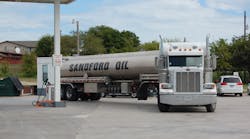Average retail diesel prices increased slightly across the country this week, while gasoline prices were more mixed, with the national average down a couple of pennies per gallon, according to data tracked by the Energy Information Administration (EIA).
The national average retail price for diesel increased 5/10ths of a penny this week to $2.271 per gallon, EIA said, though that is 60.7 cents per gallon cheaper when compared to the same week in 2015.
Diesel dipped along the Gulf Coast by 6/10ths of a penny to $2.131 per gallon – the only U.S. region to record a decline in diesel prices, according to the agency’s numbers – while diesel prices in the Lower Atlantic remained unchanged at $2.232 per gallon.
The biggest jump in diesel prices this week occurred in the Rocky Mountain region, EIA said, with a 2.2 cent spike to $2.277 per gallon.
Gasoline prices on a regional basis were more mixed this week, according to the agency’s figures, though the national average declined by two cents to $2.22 per gallon. That price is still 47.1 cents cheaper compared to the same week in 2015, EIA noted.
Four U.S. regions posted declines in gasoline prices this week:
- The Lower Atlantic: down 8/10ths of a penny to $2.155 per gallon
- The Midwest: down 6.7 cents to $2.116
- The Gulf Coast: down 8/10ths to $1.987
- The West Coast with California’s prices included: down 1/10th of a penny to $2.634
By contrast four other regions witnessed price increases for gasoline:
- The Rocky Mountains: up 4.7 cents to $2.214
- The Central Atlantic: up 1.1 cents to $2.28
- New England: up 2 cents to $2.27
- The West Coast with California’s prices removed: up 3.9 cents to $2.373
Where gasoline is concerned, EIA noted in a recent report gasoline containing 10% ethanol, commonly referred to as E10, now account for more than 95% of the fuel consumed in motor vehicles with gasoline engines in the U.S.
EIA added that Environmental Protection Agency (EPA) has issued a partial waiver allowing the use of E15 fuel – a mixtures of 15% ethanol and 85% gasoline – in model year 2001 and newer vehicles, known as “flex fuel” vehicles, with recent EIA congressional testimony estimating that flex fuel vehicles make up about 7% (16.3 million) of the current on-road fleet of light-duty vehicles in the U.S.



